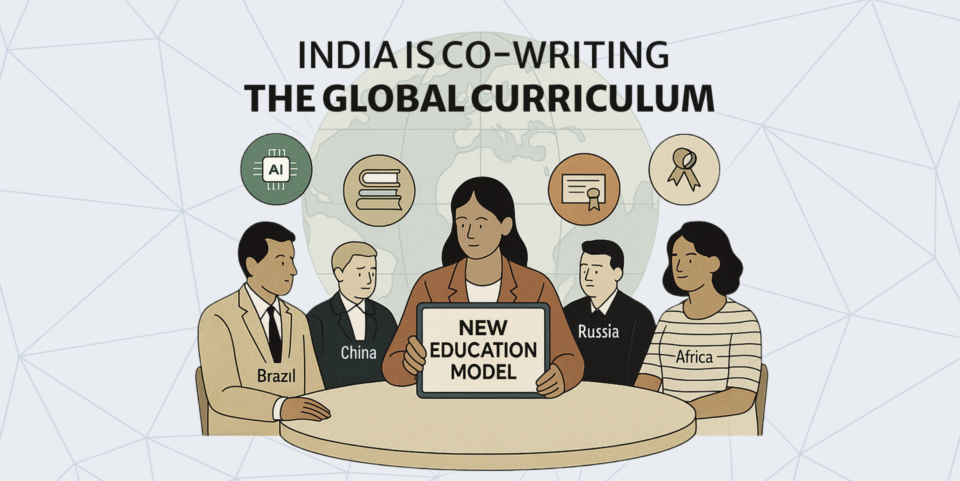At the heart of educational inequality in India is the vast socioeconomic divide.
Gender inequality is another pervasive challenge in India’s Educational Landscape. Early marriages, traditional societal norms, and concerns for safety often restrict their educational pursuits.
While government policies tailgate educational equity, it is Educational institutions that have a unique opportunity to make a difference and ensure that every student, regardless of background, receives Quality Education.

In the heart of Rajasthan, where century-old traditions hold sway- a remarkable journey of courage and determination unfolds. Meet Meera, a young girl who defied the confines of her conservative village. A village where dreams are often eclipsed by the shadows of household chores and the anticipation of an early marriage.
Meera’s story is a beacon of hope, a testament to the power of individual resolve and the transformative impact of organisations championing Education. Against all odds, Meera not only completed her schooling but also pursued Higher Education, thereby igniting a spark of inspiration in the lives of countless girls in her village.
In this article we dive deep into Meera’s story, a symbol of resilience and a reminder that the pursuit of equitable education knows no bounds. It’s a tale of how a girl’s determination is reshaping the future of an entire community and contributing to the quest for Educational Equality in Rural India.
Unveiling the Complex Tapestry of Educational Inequality
India’s Educational landscape is a complex tapestry woven with multidimensional threads of disparity. To understand the magnitude of the challenge, we must unravel the factors that perpetuate Educational Inequality. These factors intersect and intertwine, making the issue particularly intricate.
1. Socioeconomic Status:
At the heart of educational inequality in India is the vast socioeconomic divide. The financial capability of families often determines a child’s access to quality Education. Real-life stories vividly illustrate the struggles faced by innumerable Indian children.
Meet Hari, a bright young boy hailing from a modest-income family in a remote village. His parents, daily wage laborers, toil hard to make ends meet. Despite Hari’s evident potential and enthusiasm for learning, his educational journey is marked by frequent disruptions. The family’s financial constraints limit access to essential resources such as textbooks and study materials.


2. Gender Disparities:
Gender inequality is another pervasive challenge in India’s Educational Landscape. Though progress has been made, especially in Urban areas, girls, particularly in rural regions, still confront substantial obstacles to Education. Early marriages, traditional societal norms, and concerns for safety often restrict their educational pursuits.
3. Geographical Disparities:
Geographical location significantly shapes educational opportunities in India. Rural areas, weighted by inconsiderable infrastructure and a shortfall of qualified teachers, lag far behind their urban counterparts.
For instance, the children from Tribal communities residing in the far-flung villages of Jharkhand, brave challenging terrains on a daily basis to reach schools that are often in strain and poorly staffed. Remarkably, some young activists have emerged from these communities- advocating for improved educational facilities and the preservation of their cultural heritage.

Government Initiatives: Navigating Towards Equity
The Government of India has recognised the urgency to address these gaps and initiate programs to promote educational equality. These programs have played an important role in increasing access to quality education.
Sarva Shiksha
Abhiyan (SSA)

The Sarva Shiksha Abhiyan (SSA), launched in 2001, is a cornerstone program with the goal of achieving universal elementary education in India. SSA has significantly increased school enrolment, particularly among marginalised communities. While progress has been made in this regard, challenges remain in ensuring the quality of education and enhancing infrastructure and teacher training.
Mid-Day
Meal Scheme

The Mid-Day Meal Scheme is another transformative government initiative that provides free, nutritious meals to children in government schools across the nation. Beyond encouraging school attendance, this program addresses Child Nutrition and Food Security.
Beti Bachao, Beti Padhao
(Save the Daughter, Educate the Daughter)

Launched to combat gender disparities in Education, the Beti Bachao, Beti Padhao initiative is dedicated to promoting the education of girls in India. The program empowers girls through Education and actively challenges traditional norms that limit their opportunities.
Educational Institutions: Agents of Change
While government policies tailgate educational equity, it is Educational institutions that play an indispensable role in traversing the gap. These institutions have a unique opportunity to make a difference and ensure that every student, regardless of background, receives Quality Education.
Other methods such as online instruction, especially during the COVID-19 pandemic, have led to the connectivity of remote students with quality educational materials. The initiatives taken by Universities and Colleges to reach underserved communities are critical to this effort.
For example, the “Digital School” program by India’s leading Universities provides online courses and learning materials to students in rural areas. This initiative has helped bridge the digital divide, ensuring that students continue to receive quality education even in remote areas.
Role of Brand consultants:
Brand consultants can play a vital role in addressing the challenges of equitable access to Education in India. They can assist in raising awareness, building brand identities, and developing communication strategies for educational initiatives. By engaging the private sector, crafting inclusive messaging, and leveraging technology, they can help expand the reach of educational programs. Brand consultants also contribute to monitoring and evaluation, stakeholder engagement and creating a strong brand image for initiatives promoting Educational Inclusivity. Their expertise is crucial in making these initiatives more effective and impactful.
In Conclusion: A Path Forward
India’s quest for Equitable Education access is a journey filled with challenges and triumphs. The multifaceted factors contributing to Educational Inequality are being met with determined Government Initiatives and innovative efforts by Educational Institutions.
As India continues to march towards educational equity, the stories of individuals like Hari and Meera amongst countless others serve as a reminder that Education has the power to transform lives and disintegrate barriers. It’s a path forward towards a more inclusive and equitable Educational Landscape, where every child’s potential is given the opportunity and platform to flourish.
Source: The National Institution for Transforming India (NITI Aayog) Report



































